Original URL: https://www.theregister.com/2012/11/26/review_samsung_ssd840_pro_and_ssd840_storage/
Samsung SSD 840 series storage review
MLC for business and TLC for pleasure
Posted in Personal Tech, 26th November 2012 12:00 GMT
When Samsung launched its first true consumer SSD, the 470, it was met with a generally good reception. Yet the timing of its release pretty much coincided with the arrival of drives using the second generation of LSI’s SandForce controller and its 6Gb/s SATA 3 interface. Hence, the 470 having a 3Gb/s SATA 2 interface was no match for this new breed in terms of performance.
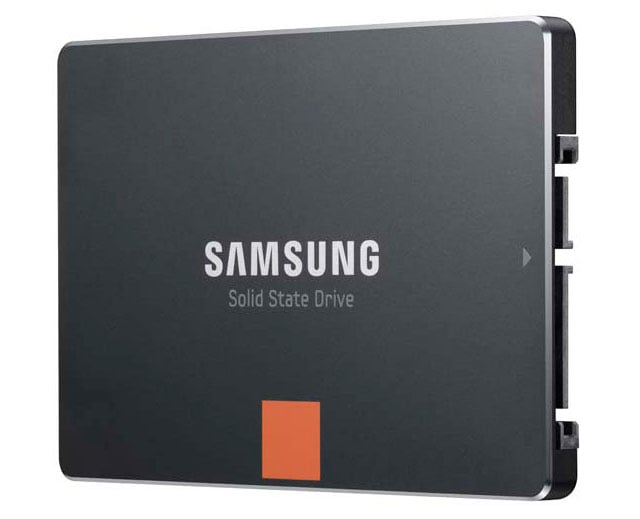
Samsung's 840 series – the next generation
Undeterred, Samsung went back to its Korean headquarters and designed a drive that’s since become a classic, the SSD 830 – a 6Gb/s model that combined high performance with a very competitive price tag, even more so recently. And not being a company to rest on its laurels, Samsung's fourth generation of SSD is upon us.
The SSD 840 series has two model lines to choose from. Both are built on a 7mm format with the 840 Pro aimed at high performance/business sector and the 840 intended for consumers. As with the previous generations, the drives are Samsung through and through, with the company producing the controller, NAND, cache chips and writing the firmware. In the world of SSDs, this is a unique position for a manufacturer to be in.
Samsung’s fourth generation controller is the MDX – coded S4LN021X01-8030. Just like the MCX chip in the 830, a three core ARM design is used. In this instance, it's the ARM Cortex–R4 clocked at 300MHz, some 80MHz faster than the MCX ARM 9 chip in the 830. The MDX supports eight channels and up 1TB of NAND with between seven per cent and 24 per cent being set aside for over-provisioning, but by using Samsung’s excellent Magician utility, this can be manually adjusted depending on need.
While the 830 had a cache of 256MB, this has been doubled in the 840 to 512MB in both the 256GB and 512GB units. Also, the DDR type has been changed to low power DDR2-1066 LPDDR2 chips. The MDX supports AES-256 encryption – something that’s normally found in enterprise class drives.
The 830 series uses Samsung’s 27nm Toggle 1.0 NAND, which supports data transfer rates of up to 133Mbps. For the 840 Pro drives, Samsung are using its latest 21nm Toggle 2.0 interfaced two-bit per cell MLC NAND which can manage much faster data transfers – up to 400Mbps.
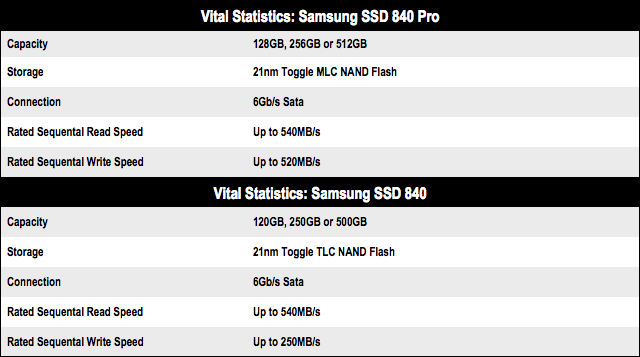
Cell division
The 840, on the other, hand uses the company’s 21nm Toggle three-bit per cell TLC (Triple Level Cell) NAND and is the first drive to market using this type of NAND Triple Level Cell NAND (TLC) Triple Level Cell or TLC NAND is an alternative to shrinking the NAND die to try and get a better density by increasing the number of bits per cell. Instead of using 1-bit per cell (SLC) or 2-bits per cell as in normal MLC NAND, TLC uses 3-bits per cell.

Same enclosure, yet vastly different tech in the SSD 840 and SSD 840 Pro
The more bits that can be packed in per cell means more GB per die and therefore more GB on a wafer without the need to shrink the die. However everything in the garden isn’t rosy. The performance of TLC NAND suffers in comparison with the other two types due to the number of control voltages used for reading and writing to the memory.
SLC has just two voltage levels to check, so random reads are very fast while MLC, with its four voltage levels, takes twice as long. TLC has eight voltage levels, so it takes twice as long again, so random reads take longer and, potentially, so does any programming.
But that’s not the only drawback with TLC featured in the basic SSD 840, the elephant in the room is NAND endurance. The actual P/E (program/erase) figures for TLC are not available yet, but as a ball park figure, it’s thought to somewhere between 1,000 and 5,000 cycles compared to the 5,000 – 10,000 of MLC or the 100,000 cycles of hyper expensive SLC NAND flash.
Given these various factors, just how well do the 840 and 840 Pro compare to each and what more do they have to offer in relation to the SSD 830? Read on.
Samsung SSD 840 Pro
The 840 Pro range capacity starts with the 128GB (£120) and goes up to 512GB (£450) and I've the 256GB (£203) unit to test. The Pros are only available as bare drives and come with a 5 year warranty.
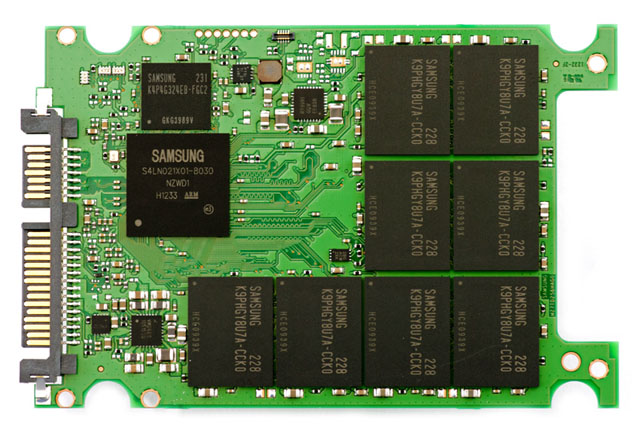
SSD 840 Pro layout
Given its business focus, the firmware (DXM02B0Q) for the 840 Pro is aimed at producing high performances under heavy loads. In addition to the 256-bit encryption, it also has WWN (World Wide Name) enabled and LED indicator support. These last two features are particularly useful when the drive is integrated into storage or server systems.
Benchmark Tests
Samsung quotes sequential Read/Write figures of 540MB/s and 450MB/s respectively for the 840 Pro, and following tests, these numbers seem pretty conservative. With ATTO benchmarking the 840 Pro notched up 561MB/s for the Reads and 528MB/s for the Writes – some of the fastest figures I have seen for a 256GB drive.
Indeed, the MDX controller doesn’t suffer from the Achilles heel that affects SandForce drives, namely, how it deals with compressible data. A quick comparison between the two CrystalDiskMark benchmark scores shows this up very nicely, with hardly any difference between the two sets of figures.
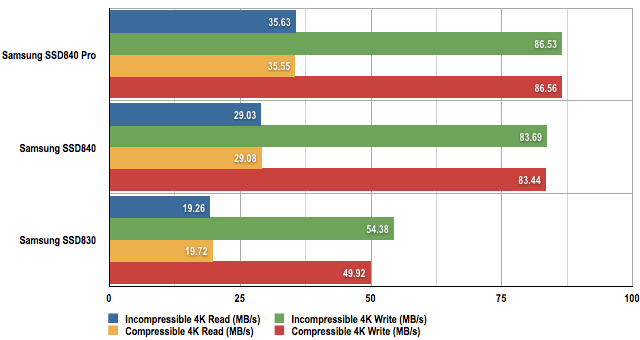
CrystalDiskMark 4K transfer rate

ATTO transfer rate
Samsung SSD 840
Unlike the 840 Pro, the 840 comes in two versions, either as a bare drive or for about £35 more, as a desktop/notebook upgrade kit. This range has a shorter warranty period than the Pro version at just 3 years. The 840 on test is the bare 250GB model, the two other capacities are the 120GB (bare drive £87) and the flagship 500GB (bare drive £343) models.
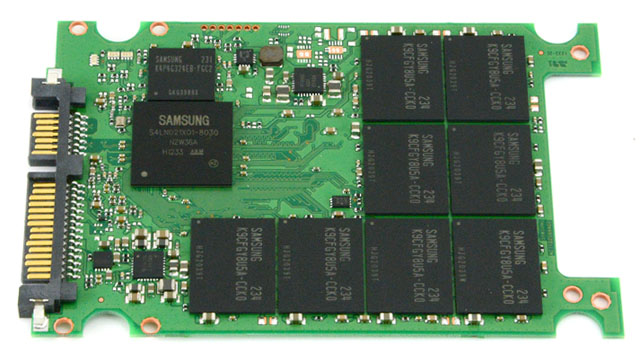
Looks familiar, the Samsung SSD 840 internals
Typically a desktop PC relies more on random read/writes than sequential read writes and so the firmware (DXT05B0Q) for the 840 series has been written to take this into account. Unlike the Pro model, it lacks the WWN (World Wide Name) and LED indicator support.
Samsung's sequential Read/Write figures for the 250GB drive are 540MB/s and 250MB/s respectively, and just like the 840 Pro, these figures seem a little cautious. Again when tested with the ATTO benchmark, more impressive Read/Write scores of 560MB/s and 263MB/s were achieved.
Verdict
The SSD 840 Pro carries on from where the 830 left off and is one of the fastest 2.5in SSDs around at the moment. It’s a little pricey compared to some of its competitors but if Samsung continues with the aggressive pricing it began with the 830, then it looks set to be the drive to buy. That said, the standard Samsung SSD 840 model appears very well-suited for consumer upgrades delivering an impressive performance and offering good value too, even at the asking price. ®
More SSD Reviews |
||||
 Plextor Plextor
M5 Pro |
 Intel Intel
330 |
 OCZ OCZ
Vertex 4 |
 Ten... Sata 3 Ten... Sata 3
SSDs |
 Kingston Kingston
HyperX |